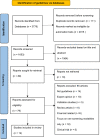Disparities in Recommendations for Colorectal Cancer Screening Among Average-Risk Individuals: An Ecobiosocial Approach
- PMID: 35599752
- PMCID: PMC9115807
- DOI: 10.2147/RMHP.S359450
Disparities in Recommendations for Colorectal Cancer Screening Among Average-Risk Individuals: An Ecobiosocial Approach
Abstract
Regardless of the high global burden of colorectal cancer (CRC), the uptake of CRC screening varies across countries. This systematic review aimed to provide a picture of the disparities in recommendations for CRC screening in average-risk individuals using an ecobiosocial approach. It was reported according to the Preferred Reporting Items for Systematic Reviews and Meta-Analyses (PRISMA) guidelines. The literature search was conducted through Scopus, Web of Science, PubMed, and EBSCOHost. Full-text guidelines which were published between 2011 and 2021, along with guidelines which provided recommendations on CRC screening in average-risk individuals, were included in the review. However, guidelines focusing only on a single screening modality were excluded. Fourteen guidelines fulfilling the eligibility criteria were retained for the final review and analysis. Quality assessment of each guideline was performed using the AGREE II instrument. Disparities in guidelines identified in this review were classified into ecological (screening modalities and strategies), biological (recommended age, gender and ethnicities), and social (smoking history, socioeconomic status, and behavior) factors. In general, unstandardized practices in CRC screening for average-risk individuals are likely attributable to the inconsistent and non-specific recommendations in the literature. This review calls on stakeholders and policymakers to review the existing colorectal cancer screening practices and pursue standardization.
Keywords: biology; colorectal cancer; disparities; ecology; guidelines; screening; social.
© 2022 Syed Soffian et al.
Conflict of interest statement
The authors report no conflicts of interest in relation to this work.
Figures
Similar articles
-
Beyond the black stump: rapid reviews of health research issues affecting regional, rural and remote Australia.Med J Aust. 2020 Dec;213 Suppl 11:S3-S32.e1. doi: 10.5694/mja2.50881. Med J Aust. 2020. PMID: 33314144
-
The future of Cochrane Neonatal.Early Hum Dev. 2020 Nov;150:105191. doi: 10.1016/j.earlhumdev.2020.105191. Epub 2020 Sep 12. Early Hum Dev. 2020. PMID: 33036834
-
Fecal occult blood test for colorectal cancer screening: an evidence-based analysis.Ont Health Technol Assess Ser. 2009;9(10):1-40. Epub 2009 Sep 1. Ont Health Technol Assess Ser. 2009. PMID: 23074514 Free PMC article.
-
Barriers and Facilitators to Colorectal Cancer Screening in South Asian Immigrants: A Systematic Review.Asian Pac J Cancer Prev. 2023 May 1;24(5):1463-1475. doi: 10.31557/APJCP.2023.24.5.1463. Asian Pac J Cancer Prev. 2023. PMID: 37247265 Free PMC article.
-
Colorectal cancer screening guidelines for average-risk and high-risk individuals: A systematic review.Rom J Intern Med. 2023 Dec 28;62(2):101-123. doi: 10.2478/rjim-2023-0038. Print 2024 Jun 1. Rom J Intern Med. 2023. PMID: 38153878
References
Publication types
LinkOut - more resources
Full Text Sources



